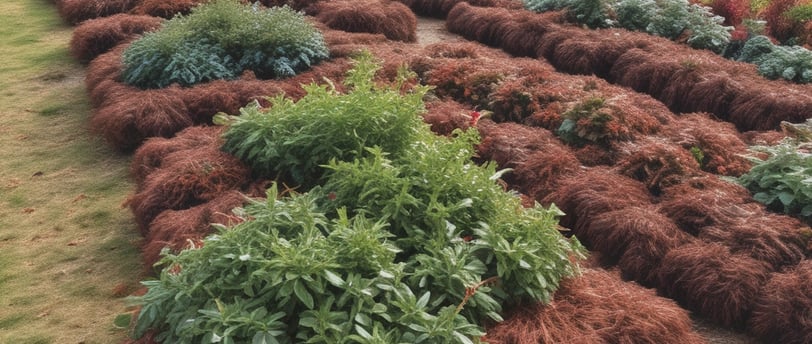Preparing Your Garden for a Scottish Winter
Preparing Your Garden for a Scottish Winter" is a comprehensive guide designed to help you safeguard your garden against Scotland’s chilly, damp winters. This post dives into essential winter preparation techniques such as frost protection, effective mulching, strategic bulb planting, and methods to shield sensitive plants from the cold. With detailed, step-by-step instructions and practical tips, you'll learn how to transition your garden from the vibrant colors of autumn to a well-insulated, healthy winter landscape. Whether you're a beginner or a seasoned gardener, this guide will ensure your outdoor space remains resilient and ready to burst into life come spring.
2/27/20256 min read


Introduction
Winter in Scotland brings its own unique set of challenges to gardeners. With its cool temperatures, persistent dampness, and the occasional frost or freeze, Scottish winters can be harsh on even the sturdiest of gardens. Whether you have a small urban garden in Wishaw or a more expansive rural space, preparing your garden for winter is essential to protect your plants and ensure a vibrant, thriving garden come spring. In this guide, we’ll take you through a comprehensive step-by-step approach to winter-proofing your garden, from clearing out autumn debris to safeguarding delicate plants with proper coverings. If you’re ready to embrace the season and give your garden the care it deserves, read on.
Understanding the Scottish Winter Climate
The Nature of Scottish Winters
Scotland’s maritime climate is known for its mild yet wet winters. Although temperatures rarely plunge to the extreme lows seen in continental climates, the persistent damp and frequent frost can still wreak havoc on garden plants. In regions like Wishaw, heavy rainfall, cool temperatures, and intermittent freezing conditions can lead to:
Soil Compaction and Waterlogging: Excess moisture may cause roots to suffocate or promote fungal diseases.
Frost Damage: Sudden freezes can cause cell rupture in sensitive plants.
Increased Pests and Diseases: Damp conditions often encourage the growth of mold, mildew, and other pathogens.
Understanding these challenges is key to preparing your garden for winter. By adjusting your garden care practices, you can minimize damage and set the stage for a fruitful growing season when the weather warms.
Step-by-Step Winter Preparation
1. Assessing Your Garden
Before you begin any winter preparations, take a comprehensive walk-through of your garden. Look for:
Signs of Damage: Check for broken branches, damaged or diseased plants, and any areas where water pools.
Debris Build-Up: Fallen leaves, spent annuals, and plant debris can harbor diseases or invite pests.
Vulnerable Plants: Identify which plants are less hardy or particularly sensitive to cold and damp conditions.
Documenting your garden’s current state can help you plan the necessary interventions and serve as a reference for spring improvements.
2. Cleaning and Pruning
a. Remove Debris:
Start by raking and removing all fallen leaves, dead plant material, and other debris. Leaving these on the ground can lead to fungal infections or create an environment conducive to pests.
b. Pruning:
Timely Pruning: Trim dead or damaged branches from trees and shrubs. This not only improves the plant’s appearance but also prevents broken branches from becoming dangerous in strong winds or heavy snowfall.
Avoid Over-Pruning: While it might be tempting to reshape your garden completely, avoid cutting back too much during winter. Many plants are in a state of dormancy and require some of their branches to help protect them from the cold.
c. Tool Maintenance:
Before storing your garden tools for the winter, clean and oil them to prevent rust. Sharpen pruning shears and ensure that all equipment is in good condition for the next growing season.
3. Soil Health and Mulching
a. Soil Aeration and Composting:
After clearing debris, assess your soil’s condition. In the autumn, the soil can become compacted from the constant moisture. Gently aerate your garden beds with a fork or a manual aerator to help water and air penetrate the soil more effectively. If you haven’t already, consider starting a compost pile using the organic matter removed from your garden. Rich, well-aerated soil will help your plants better withstand winter stress.
b. Mulching:
Mulch is your garden’s best friend during winter. Apply a 2–3 inch layer of organic mulch—such as shredded leaves, straw, or compost—around the base of plants and in garden beds. Benefits of mulching include:
Insulation: Mulch acts as a protective blanket, moderating soil temperature and protecting roots from freezing.
Moisture Retention: It helps maintain a consistent moisture level in the soil.
Weed Suppression: Mulch reduces the growth of winter weeds, which could compete with your plants for nutrients.
When applying mulch, avoid piling it directly against plant stems or tree trunks, as this can lead to rot.
4. Bulb Planting and Winter Florals
Autumn is the perfect time to plant bulbs that will bloom in the spring. In Scotland’s mild winters, planting bulbs such as tulips, daffodils, and crocuses is highly recommended.
Planting Guidelines:
Depth: Plant bulbs at a depth of about three times their height to ensure they are well-insulated.
Spacing: Allow enough space between bulbs for proper growth and air circulation.
Mulch Again: After planting, cover the bulbs with an extra layer of mulch to protect them during freeze-thaw cycles.
5. Protecting Vulnerable Plants
Some plants are more susceptible to winter damage, particularly those that are not fully hardy in the Scottish climate.
a. Frost Protection:
Covers: Use horticultural fleece, cloches, or even old bedsheets to cover delicate plants during the coldest nights. Secure the covers loosely to allow air circulation.
Temporary Structures: Consider building temporary cold frames or mini-greenhouses for your most sensitive plants.
b. Moving Potted Plants:
If you have container plants, consider moving them to a sheltered location, such as a porch, garage, or conservatory, during particularly cold spells. This prevents the soil in pots from freezing, which can cause significant root damage.
c. Watering Adjustments:
While most outdoor plants require less water in winter, don’t let the soil dry out completely during prolonged dry spells. However, be cautious—overwatering in winter can lead to root rot, especially in areas that don’t drain well.
6. Gutter and Exterior Maintenance
Winter rains and freezing temperatures can wreak havoc on your home’s exterior, making gutter maintenance an essential task.
a. Gutter Cleaning:
Clear your gutters of leaves, twigs, and debris. Clogged gutters can lead to water overflow, which may damage your garden beds and foundation. Clean gutters in both the autumn and early spring to ensure they’re free-flowing.
b. Protecting Garden Structures:
Inspect garden walls, fences, and patios. Pressure washing these surfaces before winter sets in can remove moss, algae, and dirt buildup, preventing permanent staining or deterioration.
7. Creating a Winter Garden Plan
Before winter fully sets in, spend some time planning for the next growing season. Use the quieter winter months to:
Reflect on the Past Season: Document what worked well and what didn’t. Keep a gardening journal with notes and photographs.
Research New Plants: Look into native or winter-hardy species that might thrive in your garden.
Order Seeds: Take advantage of winter sales and plan your seed purchases for spring planting.
8. Additional Considerations for Wishaw Homeowners
Living in Wishaw means dealing with specific regional challenges. Here are a few local tips:
Local Advice: Consult with local garden centers or join a Wishaw gardening group to exchange tips specific to your area.
Wildlife: Scottish gardens often attract local wildlife. Consider installing bird feeders or houses that will help protect your garden from pests while supporting the local ecosystem.
Energy Efficiency: With increased rainfall and damp conditions, ensure your garden’s design allows for proper drainage to prevent waterlogging, which could lead to mold or root rot.
Creating a Seasonal Maintenance Schedule
A well-planned schedule is essential for year-round garden success. Here’s a suggested timeline to help you keep track:
Autumn
Early Autumn: Clear away fallen leaves and debris. Begin light pruning and aerate your garden beds.
Mid-Autumn: Plant bulbs and apply mulch. Inspect and clean gutters.
Late Autumn: Protect vulnerable plants with covers and relocate potted plants if necessary. Finalize garden clean-up before the first hard freezes.
Winter
Early Winter: Limit watering; focus on indoor plant care and plan for the next season.
Mid-Winter: Check on outdoor structures and make minor repairs. Maintain a consistent temperature around sensitive plants using protective coverings.
Late Winter: Prepare for spring by ordering seeds, reviewing your garden journal, and finalizing garden layout plans.
Conclusion
Preparing your garden for a Scottish winter doesn’t have to be overwhelming. With the right approach and a bit of planning, you can transform your garden into a resilient, beautiful space that endures the chill and emerges vibrant in the spring. By clearing debris, protecting vulnerable plants, properly mulching and watering, and creating a solid maintenance schedule, you ensure that your garden is not only ready for winter but also primed for success in the coming growing season.
Take the time now to implement these strategies. Your garden will thank you when the first signs of spring begin to show, bursting forth with new life and color. Remember, successful gardening is a blend of proactive care, local knowledge, and consistent effort. Stay organized, keep a gardening journal, and enjoy the process of nurturing your outdoor sanctuary throughout the year.
Happy gardening, and here’s to a warm, healthy, and beautiful garden come spring!
If you enjoyed this post, please share your winter garden preparation tips or any challenges you face in the comments below. Stay tuned for our next guide on “Revitalizing Your Garden in the Spring: Tips for a Fresh Start.”
